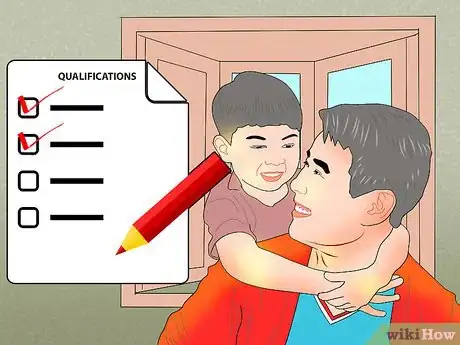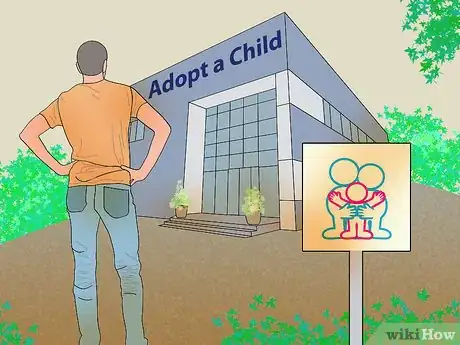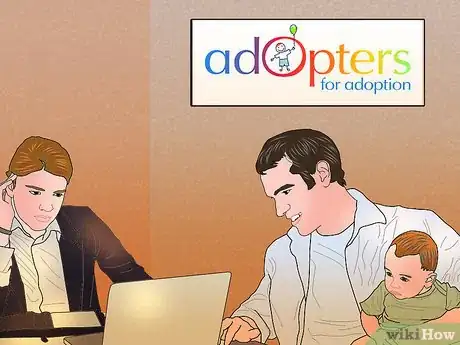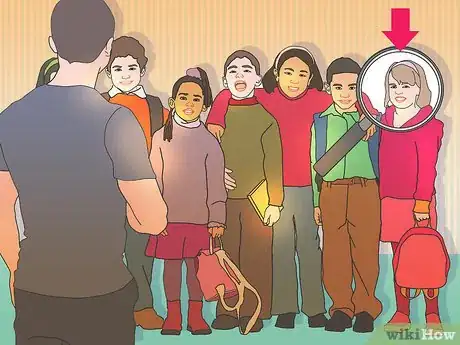This article was co-authored by Clinton M. Sandvick, JD, PhD. Clinton M. Sandvick worked as a civil litigator in California for over 7 years. He received his JD from the University of Wisconsin-Madison in 1998 and his PhD in American History from the University of Oregon in 2013.
wikiHow marks an article as reader-approved once it receives enough positive feedback. In this case, 100% of readers who voted found the article helpful, earning it our reader-approved status.
This article has been viewed 129,580 times.
The twenty-first century has opened doors for single men to pursue adoption of a child. Despite the traditional definition of family being husband, wife, and children, adoption agencies are beginning to accept single men as a potential adoptive parent. Obstacles remain, but as more children of all ages need parents and as single parenting becomes more common, men are finding opportunities to become single adoptive dads. After all, it is better to have a single supportive father than to remain in an unstable, broken home that many orphaned children emerge from.
Steps
Getting Started
-
1Make an informed decision. As a single man, you must realize the difficulties involved because of both your gender and your marital status. Recent trends make adopting children by single men more acceptable, but men are likely the most prejudiced against demographic among people looking to adopt.
- Research which countries will allow a single man to adopt a child. Not all countries are open-minded to the possibility of having one parent let alone it being a man.
- Consider your age, career, and capacity to raise an infant. It may be more suitable to prefer a teenager or a child with a disability who would love to have a father.
- Be prepared to adopt an older child or a child with disabilities. A severe shortage of adoptive parents for these children makes single men an attractive option to fill this role.
-
2Meet the qualifications. There are several different ways to proceed when considering adoption. Adoption is handled by public and private agencies, adoption attorneys, facilitators, or some combinations of this list. There are few solid rules about age, marital status, or sources of income to become a candidate to adopt. [1]
- Age requirements are flexible, but successful prospective applicants are usually in the 25-50 age range. The type of child you are adopting will have some influence on age requirements, but no actual rule exists to determine this.
- As an adoptive parent, this can be your first child, one of many children, or you can even already have adult children by the time you decide to adopt.
- Most agencies, some more reluctant than others, accept single, gay and lesbian, and disabled parent applicants.
- There are no predetermined income levels and home ownership is not a requirement either. Your income can originate from a variety of sources: employment, pension, or disability payments.
Advertisement -
3Consider the cost. The cost of adoption is expensive, but is varied depending on which agency you choose. Adopting an international, special needs teenager, through a public or government agency is more affordable than adopting a domestic, white baby, through a private agency. From the moment you begin to seriously consider adoption, start saving money in a special savings account dedicated to the process and add to it whenever possible.
- Consider the following: domestic private agency ($4,000-30,000+); domestic independent adoptions ($8,000-30,000+); and Inter-country private agency ($7,000-25,000+). The fees include most, but not all, costs associated with adoption. For international adoptions, you will also have to consider traveling and lodging costs, visas, passports, and country fees.
- Gender, race, and age of children will also dramatically influence cost. Healthy white infants are most expensive since they are the most requested and are the least available. Teenagers, because of age, and children with disabilities, because of additional care costs, are less expensive to pursue, but more available to single men. The recent trend for children of color, and in particular indigenous children, is to match them with parents who are of similar ethnicity.
-
4Select an agency. Make sure to research all the adoption agencies under consideration. Selecting an agency that is educated and experienced can relieve a lot of stress and anxiety with more positive results. Also consider their reputation, if they provide credible references, or a detailed history of their adoptions.
- Verify the agency's license by calling your state adoption agency licensing specialist to check if they are current and have no complaints lodged against them.
- Conduct a background check for either criminal behavior or lawsuits or call the Better Business Bureau for more information.
- Inquire about their services: do they offer pre- and post-adoption services?
- Find out their perspective on single-father adoption candidates.
- Request an itemized list of fees, expenses, and hidden costs.
-
5Meet the legal criteria. There are several legal requirements included in the adoption process, even more for international adoptions. Working with an attorney is expensive, therefore, be prepared to meet an extensive array of legal criteria.
- Adoption and family law is a specialization. Make sure you contact a lawyer who specializes in this field and has previous experience with legal adoptions.
- Always request references from professional people.
- Contact the Academy of Adoption Attorneys to find an appropriate attorney.
- Once you select an attorney, take their advice.
- Part of the process is providing a significant amount of personal and family history, social security cards, employment history, and financial records.
- If you have a preference, make sure your attorney knows the characteristics of the child you prefer to adopt.
Understanding the Obstacles
-
1Convince family and friends. As a single man trying to adopt, many family and friends might question your motivations and not understand why you would want the responsibility of raising a child on your own. Despite the backlash, you never have to legally worry about a family member or a friend derailing the adoption process.[2]
- Educate them regarding the benefits of adopting and how rewarding an endeavor it is. Let them know of all the benefits and joys of raising an adopted child.
-
2Make your family and friends aware of your commitment to adoption and that you have decided that this is the best for you and the adopted the child.
- Let them know that their support is crucial for the adoption to be a success.
- Try not to keep your adoption a secret unless it would bring harm to you or your child's wellness or physical well-being.
-
3Deal with adoption agencies. Although domestic adoption is legal for single men, not all agencies support that perspective. Agencies might not accept single men as potential parents, they might delay the adoption process or offer you children that they know you would not be able to handle.[3]
- It is important to demonstrate to an adoption agency that you have a plan in place and have the means to carry out. It is also a good idea to reveal your thoughts about single-parenthood to prove that you have considered all perspectives.
- Displaying true determination and assertiveness to an adoption agency will prove that you are serious about completing the adoption process and raising a child by yourself.
- As a single man, it would be wise to participate in a home study. A home study will evaluate your character, community, childhood, living arrangements, financial records, and the overall desire to adopt. Because single male applicants are not desirable among some adoption agencies, a home study will go a long way in proving your seriousness.
-
4Fight against tradition. Single-parent adoption is still highly debated. Many agencies and birth mothers will never agree to a single-man adoption because they argue that it will deprive an infant a nurturing mother and deny older children a traditional two-parent family.[4]
- Adoption agencies have established qualifications for adoptive parents based on age, previous children, financial status, employment, religion, and marital status. Even if a single man meets all of these requirements except for the marital status, they might be denied an opportunity to adopt.
- Join an adoptive parent group to discuss the obstacles and ways to overcome them. Many members will already possess experience that you can learn from. Seek out single-people only support groups (they do exist).
Adopting a Child
-
1Select a child. After you have determined that adoption is the right path for you, make a decision on what type of adoption you want to pursue. You will have to make many decisions – age, race, special needs, domestic, international, or foster – before you move forward. Take time to make the right decision.
- If you already have a child or children, think about how an adopted child would adapt to your established family structure.
- Consider the community you live in. If you choose a child with disabilities or of a different ethnic background, will they thrive in this environment?
- Think about your own abilities. Can you manage to raise an infant by yourself? Do you have the financial means to adopt a child and get them through college? Are there enough available resources around you to care for a special needs adoption?
- Stay open-minded and don't narrow the possibilities. There are many children who need good homes and families.
- Consider adopting more than one child. The more the merrier.
-
2Search for a child. Once you have completed the home study and selected an adoption agency, it is time to search for a child. Predetermine what type of child best suits your personality and lifestyle; get advice from friends and family; and network with others who have adopted in the past so that you can register for a match.[5]
- It is important to remain patient since this step could take a long time until a match is found.
- Once your home study is being reviewed for a match, information will be sent to you about the child up for adoption. This is a time when you can ask further questions. Then you must either confirm or withdraw your interest.
- Remember that case workers receive several requests and you are not the only person who may have the opportunity to adopt. The final decision will always rest on the child's needs.
-
3Discover a match. Once the case worker decides you are the right match, more confidential information is shared so that you can confirm this child is suitable for you.[6]
- Once the match is approved, the child's parental rights will be terminated so that you can adopt the child.
- If you are not chosen as an adoptive parent, you might want to consider other possible children you could adopt through your agency. Or, you could select to be a backup adoptive parent in case the chosen family declines to follow through with the adoption.
-
4Meet your child. After the initial meeting, you will make several more visits over the next few weeks or months as the paperwork is being completed. If your child resides in a different state, the child's agency will typically arrange for a minimum of two visits. [7]
-
5Receive a placement. The placement is a date when the child will arrive at your home. The adoption agency will conduct several visits during this time in a supervisory role to make sure the transition is a smooth one.[8]
- It is during this time that you file a legal intent to adopt petition.
-
6Finalize your adoption. At this point, your adopted child is officially part of your legal family once a judge finalizes everything. [9]
- An amended birth certificate will arrive with your name as the parent along with a certificate of adoption.
- Counseling and supervision will continue by the adoption agency. Take this time to talk to your child about the adoption if they are old enough to understand.
- Be a good parent by seeking out support services, connecting with other adopted families and children, and when ready, consider adopting a sibling.
Warnings
- It may not work. The adoption agency and/or social workers may not feel you're right, and it may or may not be about your gender.⧼thumbs_response⧽
References
- ↑ http://www.adopt.org/who-can-adopt
- ↑ http://www.parents.com/parenting/adoption/facts/can-a-single-person-adopt/
- ↑ http://www.parents.com/parenting/adoption/facts/can-a-single-person-adopt/
- ↑ http://www.parents.com/parenting/adoption/facts/can-a-single-person-adopt/
- ↑ http://www.adopt.org/ten-step-overview
- ↑ http://www.adopt.org/ten-step-overview
- ↑ http://www.adopt.org/ten-step-overview
- ↑ http://www.adopt.org/ten-step-overview
- ↑ http://www.adopt.org/ten-step-overview











































































